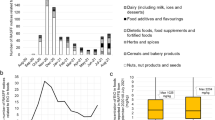Abstract
Microbiological quality and organochlorine pesticide residual contamination in raisins in a restricted area of Lucknow city, India was assessed in 20 samples. Total bacterial count was found in both open and packed raisin samples within the acceptable range (105–<106). The presence of food pathogens like Salmonella spp. and Enterobacteriaceae was detected more in open samples whereas Staphylococcus spp. and Pseudomonas spp. were absent. Lactobacilli spp. was found in all open samples and two packed samples. Presence of OCP residue was also found below the MRL although low levels of α-HCH and γ-HCH were detected in samples. The study shows presence of spoilage and pathogenic microorganisms as well as OCP residue within permissible limits which was more in open samples than in packed ones.
Similar content being viewed by others
References
Anon (1992) Compendium of methods for the microbiological examination of foods. American Public Health association, Washington, DC
Association of Official Analytical Chemist (AOAC) (1990) Vegetable product processed. In: Helrich K (ed) Official methods of analysis. AOAC, Arlington VA, pp 1058–1061
Borriss H, Brunke H, Kreith M, (2006) Commodity profile: raisins. Agriculture marketing Resource Centre-Agriculture Issues Centre, University of California, September. http://www.aic.ucdavis.edu/profiles/raisins-2006.pdf
Butot S, Putalla T, Sanchez G (2007) Procedure for rapid concentration and detection of enteric viruses from berries and vegetables. Appl Environ Microbiol 73:186–192. doi:10.1128/AEM.01248-06
Cabras P, Angioni A (2000) Pesticide residues in grapes, wine and their processing products. J Agr Food Chem 48:967–973. doi:10.1021/jf990727a
Codex (1987) Food Chemicals Codex Committee on food chemicals National Academy of Science. National Academy Press, Washington DC
Gaun TY, Blank A, Ismond A, Van Ackar R (2001) Fate of food borne bacterial pathogens in pesticide products. J Sci Food Agri 81:503–512. doi:10.1002/jsfa.835
Gilbert RJ, Louvois JD, Donovan T, Little C, Nye K, Ribeiro CD, Richard J, Roberts J, Bolton FJ (2000) Guidelines for the microbiological quality of some ready-to-eat foods sampled at the point of sale. Commun Dis Public Health 3:163–167
Gomez C, Bragualat MR, Abarca-Minguez S, Cabanes FJ (2006) Ochratoxin A-producing fungi from grapes intended for liqueur wine production. Food Microbiol 23:541–545. doi:10.1016/j.fm.2005.09.007
Kozai K, Suzuki J, Okada M, Nagasaka N (1999) Effect of oleanolic acid-cyclodextrin inclusion compounds on dental caries by in-vitro experiment and rat-caries model. Microbios 97:179–188
Kumari B, Madan VK, Kathpal TS (2006) Monitoring of pesticide residue in fruits. Environ Monit Assess 123:407–412. doi:10.1007/s10661-006-1493-7
Li Y, Mustapha A (2004) Simultaneously detection of E. coli 0157 H7, Salmonella and Shigella in apple cider & produce by a multiple PCR. J Food Protect 67:27–33
Naithani V, Kakkar P (2006) Estimation of organochlorine pesticide residue in two popular spices extensively used as herbal tea ingredients in India. Bull Environ Contam Toxicol 76:429–435. doi:10.1007/s00128-006-0939-5
Robson JN, (1976) Some introductory thoughts on intermediate moisture foods (IMF’s). In: Intermediate moisture foods. Applied Science Publishers Ltd, London UK, pp 32–40
Srivastava A, Shivanandappa T (2005) Haxachlorocylohexane differentially alters the antioxidant status of the brain regions in rat. Toxicology 214:123–130. doi:10.1016/j.tox.2005.06.005
The Ayurvedic Pharmacopoeia of India, Vol-II. The Controller of Publication, Civil Lines, New Delhi 189–1960, 2001
Tournasa VH, Katsoudas E (2005) Mould and Yeast flora in fresh berries, grapes and citrus fruits. Int J Food Microbiol 105:11–17. doi:10.1016/j.ijfoodmicro.2005.05.002
Warren R, Yuk HG, Schneider KR (2007) Survival of Shigella sonnei on smooth tomato surfaces, in potato salad and in raw ground beef. Int J Food Microbiol 116:400–404. doi:10.1016/j.ijfoodmicro.2007.02.010
Zurera G, Estrada B, Rincon F, Pozo R (1987) Lead and cadmium contamination levels in edible vegetables. Bull Environ Contam Toxicol 38:805–812. doi:10.1007/BF01616705
Acknowledgments
The authors are grateful to Director, IITR for his guidance and Institutional manuscript reviewing committee for allocation of manuscript no. 2645
Author information
Authors and Affiliations
Corresponding author
Rights and permissions
About this article
Cite this article
Sharma, S., Chandra, P., Mishra, C. et al. Microbiological Quality and Organochlorine Pesticide Residue in Commercially Available Ready-To-Eat Raisins. Bull Environ Contam Toxicol 81, 387–392 (2008). https://doi.org/10.1007/s00128-008-9506-6
Received:
Accepted:
Published:
Issue Date:
DOI: https://doi.org/10.1007/s00128-008-9506-6




